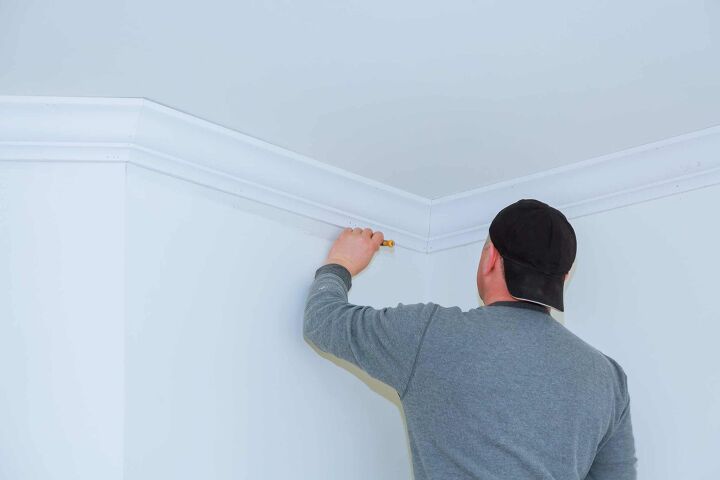Should I Put Crown Molding In Every Room?

You can expect that anything which gives a home a more elegant, stylish look to increase the overall value. The same is the case for simple, inexpensive additions like crown molding. However, it’s essential that crown molding is installed correctly and tastefully to get the most out of your investment.
If you’re considering implementing crown molding in your home, you may be wondering: “Should I put crown molding in every room?”
While this most definitely comes down to personal preference, crown molding does not have to be placed in every room to achieve a desirable effect. In fact, placing crown moldings in just the main areas of the home such as kitchens, dining rooms, and living rooms will produce a very elegant look.
Although the same effect can work in your bathrooms or bedrooms, it’s often less important to enhance the appeal of these areas as they are less traveled by occupants and guests.
We’ve outlined all the details to help you decide whether or not you should put crown molding in your home and which rooms will benefit from this additional design element.
Do You Need Interior Trim or Decorative Molding Installation?
Get free, zero-commitment quotes from pro contractors near you.

What is Crown Molding?
Crown molding was originally developed for a practical purpose. It is most often used where walls meet the ceiling in a home but can also be used for the tops of cabinets and bookcases.
Moldings and trim in general were established as a way to conceal the gaps where different building materials joined together. Since there is always a space where the ceiling meets the walls, it was originally thought that these cracks should be covered up.
Nowadays, while still maintaining its useful function, crown molding serves more as a decorative element that can be added to mostly any room in the home. Over time, crown molding has become even more elegant and is found in a variety of shapes, sizes and designs.
What is Crown Molding Made From?
Traditionally, the elaborately constructed crown moldings were made from plaster (and some still are). Plaster makes the creation of crown molding much more efficient than wood since a mold is used to repeat the pattern.
Plaster crown moldings can be easily replaced if damaged by creating a mold of the pattern and having new pieces created. Wood is another common material used in crown molding construction and is much easier to maintain and less susceptible to cracking than plaster.
Arguably the easiest form of crown molding to install is those that are made of a composite. They’re often created using PVC, extruded polystyrene, vinyl or polyurethane foam. Composite crown moldings are designed after their traditional plaster counterparts. They are also very lightweight, flexible, and resistant to pests and moisture.
You can head to your local home improvement center or consult catalogs to search for your desired crown molding design and material.
Benefits of Crown Molding
Installing crown molding on your ceilings, cabinets, or bookcases throughout a home can come with a wide array of benefits that help to enhance its appearance, enjoyment, and overall value.
- Conceals Irregularities: Fitting crown molding between walls and ceilings in a home or condo will not only offer a beautiful framing to the room, but it will also cover up cracks. Any irregularities or inconsistencies that exist in these areas will be effectively concealed to create a smoother, more seamless look.
- Various Style and Design Options: Crown molding that is custom-designed is created to both blend in seamlessly and enhance the design style. The wide range of options is endless and will allow you to find the perfect style that matches well with your home.
- High Ceilings: Introducing crown moldings on high or vaulted ceilings will almost always add depth and character to the space. It will effectively emphasize the design and overall presentation of your home. However, it should be noted that vaulted or cathedral ceilings often do not benefit from the addition of crown molding.
- Increases Home Value: Like most things with home improvement, quality matters when talking about crown molding. Purchasing the cheapest moldings on the market and haphazardly installing them will likely not impress an appraiser.
However, if special care is taken to ensure that crown moldings are installed properly and elegantly, they can increase the overall value of your home. Framing living rooms, bedrooms, kitchens and even bathrooms with crown molding can help to add a stylish look that will certainly appeal to potential home buyers.
With a number of benefits, it’s hard to deny why crown molding may a good choice to help freshen up your home. But, how do you determine which rooms to put it in and can you install it in every room of the home?
Should I Put Crown Molding in Every Room?
The exact answer to this question will depend on the home’s style and your particular decorating techniques. In short, you do not have to put crown molding in every room of the home.
However, it ultimately comes down to taste and it is perfectly fine to have it in only some rooms and also to have it in every room throughout the home.
There are certain rooms within a home that will greatly benefit from installing crown molding. For instance, the living room or family room is a very popular, classic choice to install this additional design element.
In most open-concept floor plans, the living room is often connected to other areas of the home such as a dining room, hallway, or kitchen. If this applies to you, it would make the most sense to install crown molding in these areas as well.
Some other great choices for implementing crown molding is in a main hallway, entryway, master bedroom, master bathroom, and other chic bathrooms. However, there are some areas of the home where crown molding simply may not fit.
Since crown moldings need a dedicated start and stop point and will completely surround a room, they do not work well in areas with differing ceiling heights. Also, conventional crown molding may not work or look desirable on vaulted or cathedral ceilings.
What Kind of Crown Molding Should I Install?
Like the previous question, the exact type of crown molding you should choose comes down to taste. However, here are some common concepts and situations to consider when planning out the design:
- Rooms with high ceilings look great with a wider, heavier crown.
- In rooms with elaborate details, the crown molding should be comparatively ornate.
- In terms of visual space, your crown molding and baseboard should be fairly similar.
- For small rooms or rooms with low ceilings, crown molding that has a lower profile will still look classy without being overwhelming. This will also prevent the crown molding from making the room look even smaller.
Crown Molding Misconceptions
Undoubtedly, installing crown molding can increase the overall value of your home and the aesthetic appeal of its interior. Though, there are quite a few misconceptions that often deter homeowners from deciding to capitalize on the aforementioned benefits. Some of these myths about crown molding include:
- Crown moldings should always be white. This is simply not true. Contrary to popular belief, crown moldings should be the same hue as the moldings that already exist in your home.
- My ceilings are too low for crown molding. Crown moldings are suitable for virtually any ceiling height and can actually make low ceilings appear taller.
- Wooden crown moldings are better than polyurethane. There are a number of reasons that support the contrary. In fact, one of the major advantages to opting for crown moldings made of polyurethane is that they are unaffected by frequent temperature changes.
- All of the crown moldings in your home should have the same style. The crown moldings in your home do not need to be the same. There is such a wide array of crown molding styles available and one style may better suit some rooms and not others.
Should I Install Crown Molding Myself or Hire Professional?
Installing crown molding is not considered a simple DIY project. For it to be installed correctly, it must be cut at a very specific angle, which tends to be challenging for the average homeowner to achieve accurately. Additionally, the physical mounting of the crown requires precise setting, nailing, and expert caulking.
An experienced home improvement do-it-yourselfer can generally do an effective job at installing crown molding. However, if you are at all concerned about your abilities, you should consider hiring a professional. You simply won’t be able to achieve the desired results if you don’t have the necessary skills and experience to get the job done.
Do You Need Interior Trim or Decorative Molding Installation?
Get free, zero-commitment quotes from pro contractors near you.

Wrapping It Up
Crown molding is a great way to enhance the overall appeal, add sophistication, class, and improve the value of any home. In regards to which rooms it should be installed in, this ultimately comes down to preference and the design that you are looking to achieve.
Crown molding is available in a wide variety of styles, sizes, patterns, and can even be custom-designed to fit your needs. For a more simple approach to implementing this decorative element, stick to the main rooms of the home.

Jessica considers herself a home improvement and design enthusiast. She grew up surrounded by constant home improvement projects and owes most of what she knows to helping her dad renovate her childhood home. Being a Los Angeles resident, Jessica spends a lot of her time looking for her next DIY project and sharing her love for home design.
More by Jessica Stone



























![Standard Dining Room Table Dimensions [for 4, 6, 8, 10 and 12 People]](https://cdn-fastly.upgradedhome.com/media/2023/07/31/9074335/standard-dining-room-table-dimensions-for-4-6-8-10-and-12-people.jpg?size=350x220)